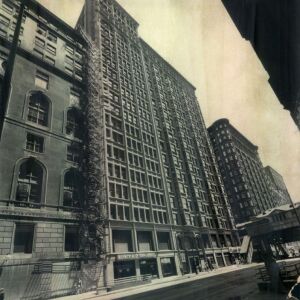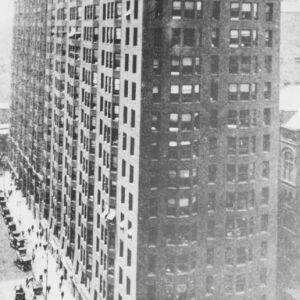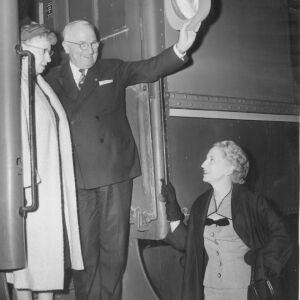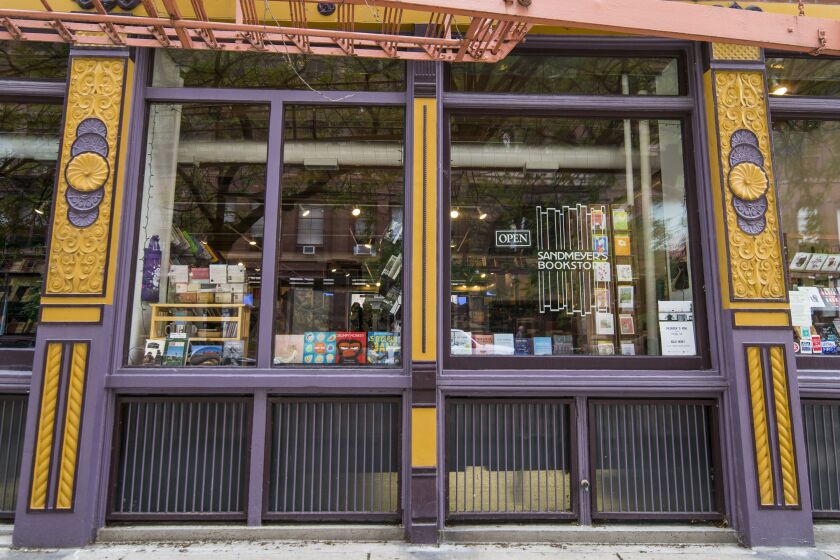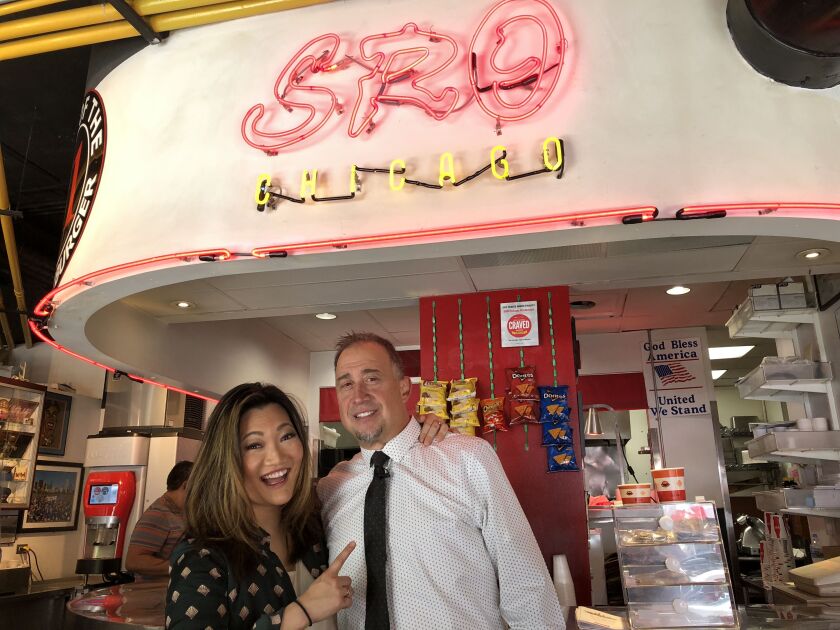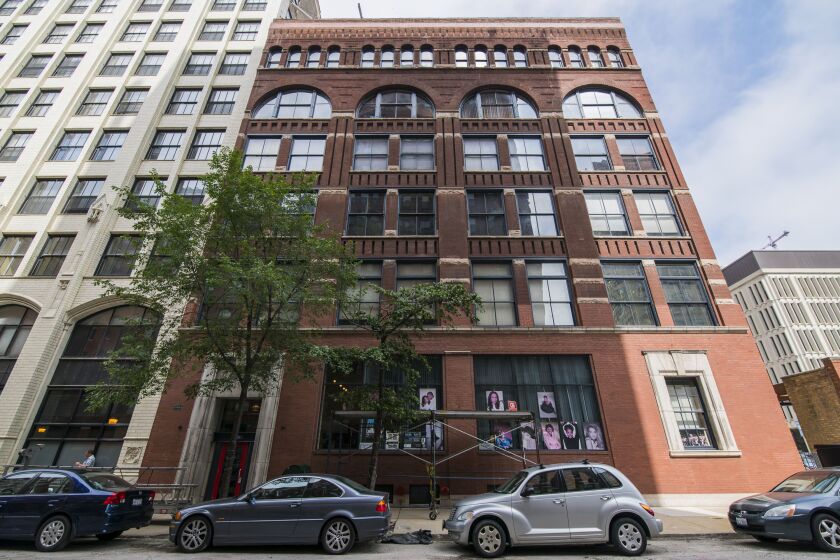Printers Row is “pocket” neighborhood between Congress Parkway and Polk Street just minutes from the Chicago Loop. After the Great Chicago Fire of 1871, the area became the Midwest hub of the printing industry with historically significant buildings designed by legendary architects like Daniel Burnham, William Holabird and William Le Baron Jenney. Today, many of those historic buildings remain but the quiet, tree lined streets are now largely residential. Of course, it continues to be a draw for fans of Chicago architecture.
Printers Row is a jewel of a neighborhood — an oasis among the hustle and bustle of city life. Here, lush residential life is but a few steps away from the full tilt of the city’s core commerce and business district.
As I walked through the little pocket neighborhood with tree-lined streets, I pictured an imaginary glass dome, like in sci-fi movies, protecting it from the relentless pace of city life. It truly does afford residents with the best of both worlds.
This large-scale terrarium of picturesque neighborhood life is no accident; it’s the result of “very intentional real estate investment by developers” according to Peter Alter, a historian at the Chicago History Museum.
History of Printers Row
In the 1880s, the neighborhood was the Midwestern center for printing, with Dearborn Station as its anchor.
Opened in 1885, the train station was the main passenger train hub that created the infrastructure for the flourishing growth of the printing industry. The access to transportation, including public transit like street cars and the L, made it possible for people and goods (raw and finished materials) to get in and out.
The area’s streets carved out long narrow blocks where building interiors admitted the maximum amount of light. Giant windows, or a line of smaller windows, would let in enough light for type setting, bookbinding and printing work done by skilled workers — who could easily commute to the neighborhood.
Publishing giants R.R. Donnelley & Sons (which also founded Lakeside Press), mapmaker Rand McNally, children’s book publisher M.A. Donohue & Company and Franklin Printing all called the area home.
The interstate and expressway system (and the use of semi trucks), faster trains and the advancement of technology (that eclipsed the Linotype machine around the 1950s, further cemented by the internet and digital printing) contributed to the “decentralization of a lot of publishing and a lot of production in general, everywhere,” said Alter.
As a result, there wasn’t a need for so many printers or for the towering, stout buildings for housing bulky, sizable print machines. Most of the printers shuttered, moved on or reinvented themselves by offering services such as marketing, brand consulting and data research. They moved out of the Printers Row, leaving many of the buildings abandoned.
Over the next 20 years, the character of the neighborhood changed dramatically, and Printers Row became a hub for prostitution, drug use and homelessness.
But in the mid-1970s, forward-thinking real estate developers began to revitalize the neighborhood by converting the abandoned buildings into residences. This flipped the backbone of Printers Row from commercial manufacturing to a gorgeous residential neighborhood.
This year, the last printer on Printers Row is moving out after decades in business. Palmer Printing, founded in 1937, has been the lone printing house in Printers Row since 2007. When it leaves, it’ll truly mark the end of an era.
But take heart, you Luddites. If you’re looking for a new hub for printers, head over to Ravenswood’s Industrial Corridor, where small, independent printers set type by hand, and screen printers employ traditional practices to produce unique and accessible art. It’s more “small batch” and artisanal than the giant book and catalogue makers of old, but it uses many of the same vintage machinery and techniques.
Architectural marvels
The vestiges of Printers Row’s history remains in its architecture. Many of the buildings, known for the publishing houses within, retain their historical names and have landmark status. Some, like the historic Dearborn Station, are also on the National Register of Historic Places. A section within the neighborhood called the Printing House Row District (the specific buildings here are the Monadnock, Manhattan, Fisher and Old Colony buildings) is designated as a National Historic Landmark District.
The architects who designed these buildings are part of what’s known as the “First Chicago School” of architecture, a style dating back the early 1880s. Legendary “First Chicago School” architects include Daniel Burnham, William Holabird, Howard Van Doren Shaw and William Le Baron Jenney.
Dearborn Station is known for its 12-story red-brick Romanesque clock tower. Construction was completed in 1885, and passenger train service stopped 86 years later in 1971 when Amtrak consolidated services in Chicago. In the mid-1980s, Dearborn Station was redeveloped as an office and retail center.
“Dearborn Station has been immortalized by, probably, the single most famous book about Chicago,” said Alter. “That is ‘The Jungle’ written by Upton Sinclair, and the main character, Jurgis Rudkus, is a Lithuanian immigrant who arrives at Dearborn Station. He looks up the canyon of dark buildings on Dearborn Street.”
The station was where many immigrants got their start. Beginning in the 1900s, nearly 17,000 passengers used the station every day. And because Dearborn Station was a terminal for southern California services, some of those passengers included well-known figures from Hollywood.
The Mergenthaler Linotype building was dedicated to manufacturing an invention that Einstein supposedly called the “Eighth Wonder of the World.” German immigrant Ottmar Mergenthaler’s Linotype setting machine, invented in the 1880s, was groundbreaking for typography and the printing world (including newspapers) because it transformed the way information could be disseminated. Linotype was faster and worked more efficiently than printmakers setting one letter at a time by hand. This history is so fascinating that there’s even a 2012 documentary about how Linotype changed printing.
The Franklin Buildings (the ornamental tile murals at the front of the entrance of 720 S. Dearborn and the older building is at 525 S. Dearborn), the Lakeside Press Buildings, the Donohue buildings (Romanesque revival style), the Morton building, Pontiac and Transportation buildings are all worth seeing and contemplating on your walk.
As for the borders of Printers Row, when I asked Alter his thoughts, he was too savvy to answer.
“I don’t weigh in on borders because they are flexible and people get mad about borders. They want to be excluded or included,” he said, “so I never weigh in on neighborhood borders.”
Smart man. And he’s a historian!
Our consensus on the borders of Printers Row are Congress Parkway to the north, Polk Street to the south, Clark Street or the Chicago River to the west, and State Street or Plymouth Court to the east. But everyone agrees Printers Row is a part of the South Loop.
Sandmeyer’s Bookstore
Since May 1982, Sandmeyer’s Bookstore has been a favorite of locals and visitors alike in Printers Row.
It’s a mom-and-pop shop with simple merchandising and minimalist black metal shelving where the books are carefully arranged for display. The ceilings are high, there’s a lot of natural light from the windows of the historic Rowe building and the floors creak as you walk around.
Ellen Sandmeyer is a petite, attractive, very polite woman with a beaming smile… and determined not to talk to me on camera. She repeats what she told me over a phone call, a few days earlier, that her husband is the one that does the interviews and she’s afraid she won’t be up to his standard. (Her husband wasn’t available at the time.)
I decided to stick around, hoping to persuade her. A perusing customer, overheard our conversation and decided to join in on the cajoling, saying it would be good for business. Too clever to be out-foxed by us but too polite to refuse two people — including a paying customer — she obliges with a disclaimer that this won’t go well. (It does.)
Ellen and her husband Ulrich were early settlers into the neighborhood during its turnaround phase from abandoned, neglected buildings to a residential enclave. “Only a couple of buildings had been converted to loft buildings,” Ellen said. “It was pretty empty around here when we opened, but the neighborhood’s been so supportive, and we’ve continued to grow over the years.”
The couple — both librarians, Ulrich with the Chicago Public Library and Ellen as a law librarian at DePaul University — dreamed of opening a bookstore. Then, they did.
“My husband had a great eye,” Ellen says proudly. “He believed that this neighborhood would develop and we were just getting in on the ground floor.”
And boy, Ulrich was right. “It did, but we ate a lot of hot dogs for a while,” Ellen said, laughing. She added: “But you don’t open a bookstore to get rich.”
No, you certainly don’t. But it’s clear why Ellen is in the business. She is absolutely charming; for someone who was afraid she wouldn’t interview well, she lights up when speaking about her husband and books. I’m guessing those are two of her greatest loves.
“We choose the books on display and love to talk to people about them,” Ellen said. She’s a voracious reader and cares about matching the customer to just the right book.
When asked what people should read, she says people should read informative books — here, she interjects she’s reading “Death and Life of the Great Lakes,” which she said was “fascinating and disturbing” but added, “it’s also important to read things that give you a break from the worries of every day, with beautiful language.”
Ellen says the bookstore is “an opportunity to come and find something [customers] didn’t know they were looking for, and actually hold it in their hands, look at it and smell it. It’s all right to write in them, and it’s great after you’ve read it to share it with someone.”
She’s too humble to say it, but I think the best part of buying books at her shop is the opportunity to converse and interact with Ellen and the store’s other knowledgeable, caring booksellers. It’s a wonderful way to feel connected, not to the history of Printers Row, but also to incredible people who now work in it.
Kasey’s Tavern
William White goes by the name Bill and has owned Kasey’s Tavern for 33 years. I wasn’t prepared for how much knowledge White was going to unleash on me about the history of his bar or about Printers Row.
White is a licensed realtor, has a law degree, bartended and did much of the repairs and refurbishment of the bar on his own. His business card is stamped “most interesting man in the world” — not due to arrogance, but a very good sense of humor. His tavern occupies space in the historic Donohue building.
“In order to get the builders to stay around the buildings during that time, they put a tavern in first. This was the first occupied space in the building, as it was being built. The whole building was built in four months,” said White.
Since 1883, the space at 701 S. Dearborn has been continuously occupied by some type of bar, tavern or restaurant that served alcohol.
Casmir “Kasey” Weglarz bought the tavern in 1974. According to White, Weglarz was an eccentric, colorful character that “started bootlegging with potato skin vodka and had a liquor route on Milwaukee Avenue and the Polish areas. He wanted to open a tavern, but he wanted it to be Irish, so he named it Kasey’s.”
In 1984, White wanted to buy a bar and couldn’t find one he could afford. At a friend’s suggestion, White approached Weglarz.
There was only one problem — the bar was never open. The storefront was wood, and regulars would be admitted but the door would be locked. It took White two years of trying before he was able to finally meet Weglarz. (White later discovered the locked door was essential since Weglarz also was running a bookie operation, with four pay phones on one wall to take in bets. Through the back door printers would give tips on which horse looked the best – they would know, since they were publishing the stats.)
“He was a pretty contrary old Polish guy,” said White. “He wasn’t even sure he was going to sell. He was just going to lock the door and leave when his lease was up and just walk away. But I convinced him over a period of six months.” White kept Weglarz on as bartender during the day, and White worked nights.
The neighborhood was still transforming when White bought the tavern. “Transportation Building, Franklin, and Rowe were abandoned. Moser, Pope, Lake Press were all empty,” said White. “People thought I was silly and my friends thought I was crazy… First off, no one’s heard of the South Loop or Printers Row. No one ever thought of going south of Congress. At that time, no, this was an abandoned neighborhood… it was a pretty sketchy place.”
Then slowly, one by one, the old printing buildings were developed into residences. “It was like I was a genius, but it was pure blind luck. It was the only place I could afford to buy if I was going to be in the bar business,” said White. “Every night if there weren’t customers here, I was working on the wood floor — first started in July of that year and finished on Thanksgiving.”
Where to eat and drink
- If you’re headed to a friend’s place for dinner or need to pick up some libations for your own abode, head to the Printers Row Wine Shop. Opened in 2004, the staff is knowledgeable, and the selection is fantastic. The wine shop also has free wine tasting events where you can test out the goods before making a commitment.
- The same owners bring options to the area with Flaco’s Tacos, Gordo’s and HAX. HAX was recently renovated from Hackney’s and feels more fast casual with plenty of room to hang out. Next door is Gordo’s, where you get a custom ice cream bar of your choice, dipped in chocolate and rolled in some typical and unusual toppings, like cookie crumble or Fruity Pebbles cereal.
- For date night, try Sofi Restaurant, which focuses on Northern Italian cuisine like Ossobuco alla Milanese.
- First Draft is all about comfort foods like fried pickle chips, pretzel sticks and porkcicles (pork shanks covered in either buffalo or barbecue sauce). But, as the name suggests, there are also a lot of draft brews you can choose from.
- Half Sour fills in the void left when beloved restaurant and bar Blackie’s closed. The restaurant’s name refers to a pickle that’s fermented for only a couple of days so it remains crunchy and green. The menu is inspired by a Jewish deli, but with a modern twist.
- Head to Sociale if you’re looking to share small plates (hot and cold) with friends and well-crafted cocktails. During the week, there are great specials for happy hour.
- Villains Black Market Craft has a selection of over forty draft beers and over a dozen options for burgers/sandwiches showcasing carefully sourced ingredients from local farms like Nichols, Spence, Klug and Slagel.
Meli Cafe
Meli Cafe has three locations in the city, but its Printers Row location (500 S. Dearborn) is the largest, and the only location that serves dinner. Located in the historic Morton building, it’s the attached restaurant for the boutique Hotel Blake.
Owners Nick Karabelas and Yianni Theoharis are Greek immigrants who have been friends since before they opened up Nine Muses in Greektown in 1990. After they couldn’t find the types of brunch with the quality ingredients they wanted, the pair opened the first Meli in 2006.
Meli (which is the Greek word for honey) uses top notch ingredients. The restaurant imports Greek honey, uses real maple syrup and organic eggs, and has a juice bar that churns out freshly squeezed juices and smoothies. You can indulge in pancakes, crepes and waffles, or opt for healthier vegan options. Meli also has gluten-free modifications.
My favorite is from the “secret” menu at the Printers Row location — the Yanni’s Garage Breakfast Sandwich, a brioche bun with scrambled eggs, pecan wood smoked shoulder bacon, caramelized onions, sharp cheddar cheese and chipotle ketchup.
Meli also sells an Elvis French toast and churro French toast found only on the “secret’ menu. (You can go ahead and thank me now.)
SRO Restaurant
When Standing Room Only restaurant opened in March 1993, it was only 900 square feet. That’s one reason why the name was a perfect fit.
“When we first opened, we only had twelve seats. And at the time, smoking was still allowed, so three seats were smoking and nine seats were non smoking,” said owner Tom Bezanes. “When the door would open, leaves and snow would blow in at peoples’ feet. It was really a tight, tight space.”
Bezanes owns the restaurant with his brother Dino. The name harkens back to their childhood memories and love of sports. “When we were young and we were trying to get into Chicago stadium to the Bulls and Hawks games, we couldn’t get in. Most the time we would go to Gate 3 and pay for standing room only,” said Bezanes.
There’s a lot of sports memorabilia in the restaurant, including 15 feet of original dasher board from the Blackhawks, a chair from the Michael Jordan era of the Bulls, a Walter Peyton jersey and a poem written by Ernie Banks on an SRO menu — to name just a few.
In 1996, SRO was able to expand into the shop next door and now holds around 50 seats. There’s also an outdoor patio with around 40 seats. The food is fast casual but with fresh ingredients (no frozen chicken or burger patties) made to order. It’s simple, straightforward and incredibly fast. I’m a fan of the char chicken Caesar salad and the grilled cheese, but you can also get a burger or gyro.
“It’s a meeting place, it’s a cross sections of Chicago — students, Board of Trade, federal prosecutors, postal workers, all our wonderful residents that have been around for all these years. It’s a fun place,” said Bezanes.
Other things to check out
Jazz Showcase
The Jazz Showcase is the oldest jazz club in Chicago. It was founded by Joe Segal in 1947 and is now run by his son Wayne Segal. The club has moved several times since it was founded in the Gold Coast neighborhood, but found its current home in the Dearborn Station in 2008. The greatest jazz musicians of all time have graced the stage and continue to do so.
Printers Row Lit Fest. The printing and bookmaking history of the neighborhood prompted the start of this popular book fair in 1985. First called the Printers Row Book Fair, the weekend long celebration of books features book vendors, author interviews and more.
Bespoke Men’s Grooming is a place where guys can get expert consultation on hair cuts, color, beard grooming and waxing. It looks really hip, and they can even take care of your “groomsquad” on your wedding day.
Chicago Bicycle Company is an independent bicycle shop with two locations, the one in the heart of Printers Row offers a personal shopper service with a bike expert.
What residents have to say about the neighborhood
Alondra Ibarra is president of the Roosevelt University Student Government Association. She shared with us her five favorite things about Printers Row.
- Jazz Showcase: If you love jazz, this is the place for you. The venue isn’t particularly big, but it is very cozy and has a cute vintage aesthetic to it. You can typically see the developing talent of the jazz ensemble of the Roosevelt University College of Performing Arts. More, it always has great international, national, and local performers! Pro tip: College of Performing Arts performances are usually free!
- Pauly’s Pizza (719 S State St.): Cheap pizza but very good. If you’re a pepperoni lover, have them add basil to your slice. Also, what is considered one slice is actually two slices put together! I would recommend getting the pomegranate Italian ice for dessert.
- Flaco’s Tacos (725 S Dearborn St.): Margarita Mondays and Taco Tuesdays. That’s all you gotta know.
- Devil Dawgs (767 S State St.): Hands down, the best milkshakes and fries. The burgers are delicious too, but are nothing without a shake or the fries. It’s a whole experience. My favorite milkshake is the Dark Chocolate.















